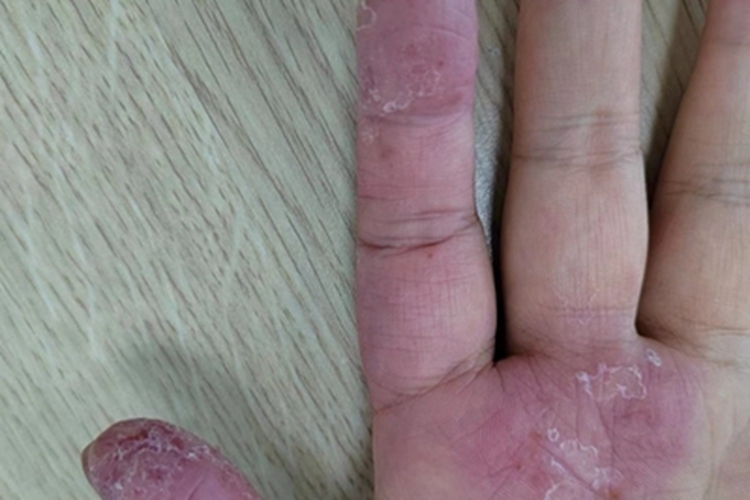
You notice it while washing your hands or gripping the steering wheel—a persistent, blotchy redness on your palms. It might feel a little warm, perhaps even slightly itchy. Your first instinct is to reach for the moisturizer, chalking it up to another patch of dry skin that comes with changing seasons or age.
But what if this redness is different? What if it doesn’t respond to your usual lotions and seems to have a life of its own? In such cases, these red patches on your palms aren’t just dry skin. They are very often a silent flare, a visible signal from your liver that it is under significant duress.
This condition has a name: Palmar Erythema. It sounds clinical, but it simply means “redness of the palms.” And its distinctive pattern is the key to distinguishing it from common dryness.
How to Tell the Difference
- Dry Skin: Is usually generalized, flaky, and can affect the backs of your hands and fingers. It responds to moisturizing.
- Palmar Erythema: Has a very specific “blotchy” or “mottled” look, like a collection of small, red patches. Crucially, it is most pronounced on the heel of the palm (the hypothenar eminence) and the fleshy mound at the base of the thumb (the thenar eminence). The center of your palm and your fingers may be much less affected. It is a redness that comes from within, not from the surface.
The Liver Connection: Why Your Palms Are the Messenger
Your liver is your body’s primary filtration plant, responsible for processing everything from nutrients to medications to toxins. It also helps regulate your hormones.
When the liver is damaged or overworked—due to conditions like cirrhosis, hepatitis, or non-alcoholic fatty liver disease—its ability to function is impaired. One consequence is that it cannot properly metabolize and clear certain hormones and vasoactive substances from the blood.
The result? Small blood vessels in your hands (and sometimes the soles of your feet) dilate and expand, creating a constant state of increased blood flow right under the skin. This is what produces the warm, red, blotchy appearance on your palms. Your palms are acting as a billboard, displaying a message about the congestion in your internal processing plant.
Other Potential “Senders” of the Signal
While a stressed liver is a primary cause, it’s important to know that your palms can also reflect other systemic issues. These red patches can also be your body’s way of saying:
- “We have a hormonal shift underway.” It is very common and normal in pregnancy due to increased blood flow and estrogen. It can also occur with autoimmune thyroid conditions like Graves’ disease.
- “There’s an autoimmune alert.” Conditions like rheumatoid arthritis can sometimes present with palmar erythema as part of their systemic inflammation.
- “We’re having an allergic or medication reaction.” Certain drugs can trigger this as a side effect.
What to Do When You See the Signal
This is not a reason to panic, but it is a powerful reason to pay attention. Ignoring it is like ignoring a “Check Engine” light that’s specifically flashing for your body’s main filter.
- Don’t Self-Diagnose: This is a symptom that requires a professional interpretation.
- Schedule an Appointment with Your Doctor: Be prepared to tell them how long you’ve had it, if it’s on both hands (it usually is), and any other symptoms you may have, such as:
- Unusual fatigue
- Nausea or loss of appetite
- Jaundice (a yellowing of the skin or eyes)
- Swelling in your ankles or abdomen
- Be Ready for Tests: Your doctor will likely order blood tests to check your liver function (Liver Function Tests or LFTs) and may want to check for other conditions like thyroid issues or rheumatoid factor.
These red patches on your palms are more than a skin concern. They are a direct, visible connection to your internal health. By understanding this signal and taking the simple step of talking to your doctor, you move from being a passive observer to an active guardian of your well-being. You’re not just treating a red patch; you’re answering a call to ensure the health of one of your body’s most vital organs.